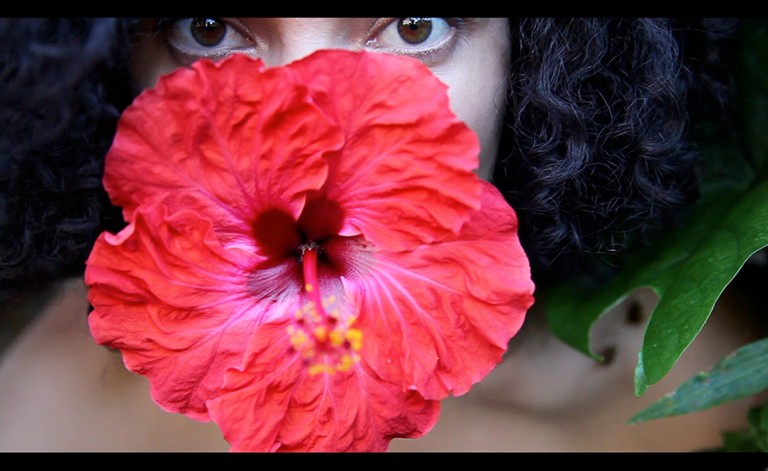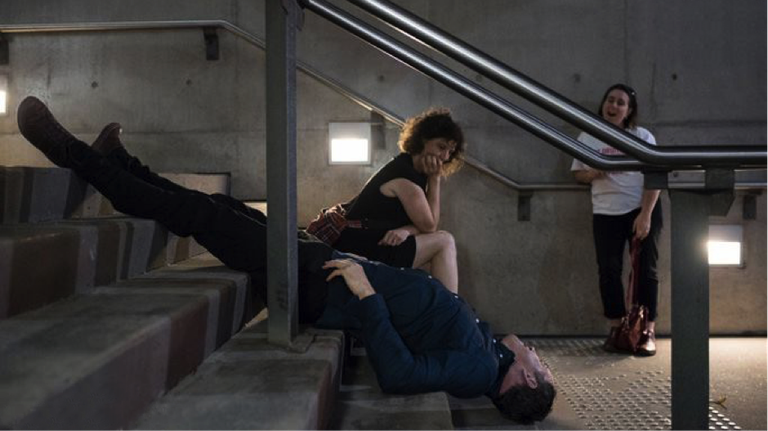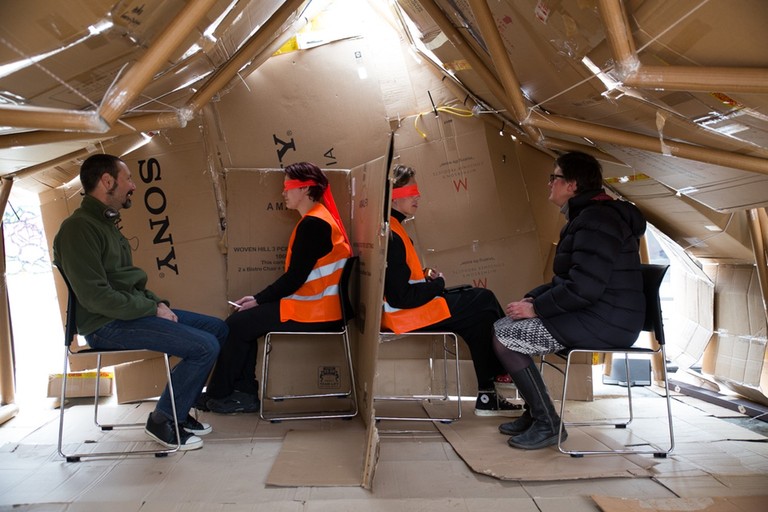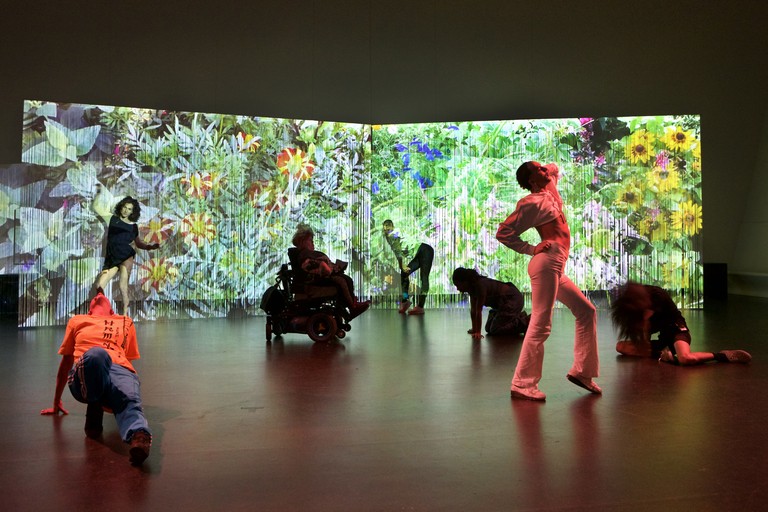The Occasional Journal
To find a place
April 2018
-
Editorial
Louise Rutledge -
Free arguments: [Under construction]
Layne Waerea -
Pointing out event-lets
Victoria Wynne-Jones -
Radical Silence in Performance Art: Kalisolaite ‘Uhila’s Maumau-taimi’
Chris Braddock -
I instagram myself to sleep, 2016–2017
Sione Monu -
Waiting for love in library aisles
Natasha Matila-Smith -
Who’s missing and how can we reach them?
Dilohana Lekamge
Pointing out event-lets
Victoria Wynne-Jones
Making an event—however small—is the most delicate thing in the world.1
The above quotation from Gilles Deleuze and Claire Parnet is one that often comes to my mind when ruminating on performance art practice. This provocation, the delicateness of making an event, is for me, indelibly linked to a phrase from another French philosopher, Hélène Cixous: “No need for plot or action; a single gesture is enough, but one that can transform the world.”2 In tandem, these ideas conjure up a kind of “Occam’s razor” approach to performance, an enjoinder for artists to keep things simple and to avoid what is unnecessary.3 Such an approach might envisage performance at a zero degree point, a point that, according to semiotician Roland Barthes, is marked by a sense of negative momentum.4 What lingers on from these statements is the idea of performance degree zero—the realisation of an event, however small, one that might involve a simple and refined gesture.
When considering the delicateness involved in making an event and the simplicity of certain gestures as realised in an instance of performance art, I remember an anecdote told by artist and educator Tessa Laird. Whilst teaching at Elam, Laird invited Frank Fu, then a second-year art student, to do a performative intervention into one of her lectures. Laird recalls:
Because it was a morning lecture, he just showed up with his toaster and made toast throughout the lecture, and ate it, and offered toast to the other students. It was very laid back and natural. In fact it made me wonder why we couldn’t just do that all the time!5
I can appreciate the gesture of responding to an invitation to perform by turning up and making toast. However, in the interest of a more generative discussion of performance art, I have excavated, from some prior research, a series of unresolved questions and posed these to artists Audrey Baldwin, Alicia Frankovich, Mark Harvey, Robyn Jordaan and Angela Tiatia.6 The questions asked were as follows:
- Can performance art express and sustain public excitement?
- Is it capable of bringing marginalised individuals together, forming new groups and consolidating them?
- Can performance be part of an effort to restore wounded societies?
- Might a performance create sentiments of hope and solidarity among distressed peoples in the face of disarray?
- Does performance ever encourage a rallying to lost causes?
- Can instances of performance art act as ways of sustaining collective human actions, even those that are destined to fail?
- Can performance artworks strengthen and stabilise marginalised communities?
Performance is very much a “contested concept,” for, as theatre scholar Marvin Carlson points out, the concept seems to have disagreement built into it.7 Nevertheless, Carlson brings together some integral elements of performance in general through what he calls “social performance.” For Carlson, performance involves a “certain distance between ‘self’ and behaviour”—it is an “activity carried out with a consciousness of itself.”8 Crucially, it involves “display”, often of “a recognized and culturally coded pattern of behaviour.” Carlson’s thesis of social performance describes the way in which “our lives are structured according to socially sanctioned modes of behaviour,” suggesting that all human activity carried out with a consciousness of itself could potentially be considered as “performance.” Many of Carlson’s arguments are applicable to instances of performance art that take place within museums and galleries, as well as those that are pre-recorded, exhibited or streamed on-line as they frequently involve events that incorporate the display of various kinds of behaviour.
Moving on from Carlson’s theories to the core questions asked above, displayed bodies can be one form of technology utilised by performance artists to draw attention, create spectacles, express or sustain public excitement. Events might be made with the aid of the bodies of artists or performers, as well as participants. Indeed, Auckland-based artist Robyn Jordaan observed that performance often involves “one person placing themselves in a vulnerable space.”9 Jordaan surmised that even though audience members are “fearful of outward expression,” they are also “always forever curious.” She describes the way in which performance artists “place their bodies on site,” pointing out that “you cannot consume the body of a performance artist but merely experience it.”
Linking with Jordaan’s assertions about placing oneself in a vulnerable space, Sydney-based Angela Tiatia declared:
Performance art for me provides agency in a sense that the work can make some movements towards healing, opening or acknowledging wounds. It’s a statement of where the artist is at in their thoughts or art practice in that particular moment of time.10
Hibiscus Rosa Sinensis (2010) is an example of a work that for Tiatia was “empowering in the moment of action,” one that became healing due to the way in which it gave her a sense of being in control of her body.11 In this recorded performance, Tiatia “refuses the signs attached to the body,” signs such as the hibiscus flower worn to signify sexual or intimate availability. Rather than wear the flower behind the left or right ear, in this work Tiatia refuses what Carlson refers to as “culturally coded patterns of behaviour,” choosing instead to place the hibiscus in the very centre of her face, in her mouth, before slowly devouring it.

Angela Tiatia, Hibiscus Rosa Sinensis, 2010, still image from digital moving image, 1 minute, 31 seconds, single-channel High Definition video, 16:9, colour, no sound. Image courtesy of the artist.
Whereas Tiatia uses performance artfully to undermine culturally specific signifiers of femininity and availability, Auckland-based artist Mark Harvey posits that performance can activate “a sense of the idiotic (that which we cannot contain)” and calls into question the way “identities are performatively contracted with others.”12 In Life Tips (2017) Harvey lies upside-down upon a stairway while welcoming people and inviting them to exchange life tips. According to Harvey, visitors were not necessarily excited, however they were taken off-guard, simultaneously disarmed by the stupidity of the action as well as the niceness and humour of the exchange. Harvey acknowledged that the performance “plays on the sense of white-man authority… this middle-class looking guy in a nice shirt.”13 Like Tiatia, Harvey plays with culturally coded patterns of behaviour. Rather than using stairs in order to decorously walk from one floor of a building to another, he lies down upon them, self-consciously displaying himself as well as his incongruous behaviour. Life Tips is an event that involves the display of an artist’s body as idiotic, a term performance theorist André Lepecki describes as involving someone who isolates or separates themselves in some way.14
Continuing the theme of idiocy and recalling Barthes’ point about negative momentum, Harvey also responded to the possibility of performance art as encouraging a rallying to lost causes, positing that “perhaps the idea of doing performance art for the sake of itself is a lost cause.”15 This idea of performance art as a lost cause ties into an argument that dramatist Antonin Artaud made about theatre, one which could equally be applied to performance, that it involves a “momentary pointlessness” which drives one to “useless acts without immediate profit.”16 For Artaud, such acts are as futile as looting in the midst of a deadly plague, which taken together with Occam’s razor, suggests that performance art itself may be unnecessary.

Mark Harvey, Life Tips, 2017, performance, Performance Space, Carriageworks, Sydney. Image courtesy of the artist.
Returning to the point Jordaan made about performance art involving “bodies on site”, an art gallery can act as a site of encounter, a space where performances frequently take place and are brought into contact with audiences. In a series of public lectures, art writer Chris Kraus posited that the “art world has become the last refuge for the humanities and its debased professions of social work, school-teaching, translation and literature.”17 This might be a good moment to complete Parnet and Deleuze’s epigraph: “Making an event—however small—is the most delicate thing in the world: the opposite of making a drama, or making a story.”18 Correspondingly, it can be argued that the art gallery in general and performance art in particular have become refuges for those uncomfortable about being pressured to make dramas or stories, those seeking a reprieve from the discipline-specific demands of theatre, dance (as is the case for Harvey) or even television (as is the case for Tiatia). It is within such spaces that the delicateness of the event meets the “minimal things” that are relations with others. According to philosopher Rodolphe Gasché, relations are small and elemental, yet even so are “the most basic and simple of all philosophical problems.”19 Gasché’s proposition that relations are problems raises yet another question: What kinds of inter-personal relations might be activated by performances?
In considering her own work, Tiatia reflected that “for me, the connections and the beginnings of the opening up of conversations after the performance are the most healing or useful. It’s never in the moment of performing.”20 Similarly, for Christchurch-based artist Audrey Baldwin, performance involves responding, something that takes place within a public space that can act as a kind of “salve.”21 Of the artists interviewed, Baldwin responded the most strongly to McNeill’s arguments for “muscular bonding” in her descriptions of performance art that is explicitly socially-engaged. In response to the Christchurch earthquakes, Baldwin organised performance works in public spaces as “a prime example of healing, bringing communities together,” creating therapeutic situations that enliven the city and strengthen artistic communities, as well as give encouragement to practicing artists so that they might have reasons to stay in Christchurch. With the support of Toi Moroki Centre of Contemporary Art, Baldwin worked with Christchurch youth to create CARDBOARD CONFESSIONAL, (2016) a temporary cardboard structure mimicking that of the “cardboard cathedral” where members of the public were invited to confess their frustrations as well as the challenges of living in Christchurch. The location of the structure in a public place and the performance’s Saturday afternoon timing meant that a wide range of people who might not normally seek out performance art were able to engage with the work. Additionally, Baldwin indicated that CARDBOARD CONFESSIONAL also “brought together a group of queer kids, who created friendships through working and performing together in a typically conservative town.” Thus CARDBOARD CONFESSIONAL, a collaborative and participatory performance, was indeed part of an effort to restore wounded societies and to create sentiments of hope and solidarity among distressed people. For Baldwin, like Tiatia, what happens after a performance is important in terms of the gatherings, conversations and shared reflections it might enable.

Audrey Baldwin, Oscar Bannan, Bridget Harris, Neil MacLeod, Annemieke Montagne, Patricia Parkin, Jennifer Katherine Shields, CARDBOARD CONFESSIONAL, 2016. 12:30 p.m. – late afternoon, 91 Hereford St (Spark Park), Christchurch.
Continuing with the terms of the relations between performers and beholders, Berlin-based Alicia Frankovich responded to the proposition that performance might bring marginalised individuals together in order to form and even consolidate new groups. For Frankovich, there is the possibility that the “shared subjectivity” or experience of a performance such as Atlas of the Living World (2017) can create conditions so that people can be temporarily “bound together by a certain situation or a given set of circumstances.”22 Created for an auditorium in Amsterdam’s Stedelijk Museum, Frankovich’s Atlas consisted of a live, performative exhibition environment—a choreography involving ten performers presented before an immersive video installation.23 Frankovich engages with concerns about identity formation, ones shared by Tiatia and Harvey, and inflects these to include notions of collectivity and contingency. Trained and untrained performers were cast by Frankovich in order to highlight multiple abilities, personalities and ways of being. Whereas usually a sense of bodily closeness might form over an extended period of time, Frankovich instead posits that a situation realised by a performance might “speed up” a shared sense of responsibility over the course of its duration, so that alliances between bodies might form. For Frankovich, such a relation or sense of bodily closeness is special, formed during an event from the “generosity of the artist, performers or perhaps audience members.” In order for this to happen one must give oneself over as a viewer, beholder or performer so that there might be “a shared, collective empathy in the room.” Importantly, Frankovich’s Atlas creates a topography or map of a living world that is not restricted to performing bodies that are human. The work is a nature documentary that is queered, dis-orienting the didactic and anthropocentric conventions of the genre. The visual content projected behind the performers involves immersive documentary-style videography, underwater footage and nature imagery paired with a fragmented sound score rather than the more usual swelling orchestral score or narrator with an upper-class, educated British accent. Inspired by the writings of feminist Karen Barad and bioethicist Vicki Kirby, Frankovich evokes other kinds of bodies, the non-human, indeterminate life forms of fish and plants as well as queer life forms such as amoeba.

Alicia Frankovich, Atlas of the Living World, 2017, Stedelijk Museum Amsterdam. Image courtesy of Ernst van Deursen. Stage, scenic and light design: Alicia Frankovich. Music: Igor Kłaczyński. Cast: Nadia Bekkers, Angelo Custido, Astrit Ismaili, Bear Silver, Cailin Kuit, Joy Mariama Smith, Ksenia Perek, Mavi Veloso, Matthijs Walhout, Nelle Swan. Crew: Karen Archey, curator; Henri Sandront, producer; René Vos, technical producer; Max Litjens and Bente van der Burgh, assistant interns.
Sagely, Tiatia muses that she would be “worried” if any performance was “done with a sense of providing a solution or ending or a ‘full stop’. Performance art is a questioning or a note or a poem that seeks connection with others through gestures.”24 Indeed, indeterminacy and questioning, rather than fixity and stasis are integral attributes of performance art and this is one reason why this text is structured around interviews with practising artists. Instances of performance artworks will always erode or challenge prior attempts to thematise or theorise them. For example, earlier on in this piece I discussed a proclivity for performance artists to shy away from drama, theatre and narrative. In contrast, Frankovich’s Atlas of the Living World deliberately utilises practices relating to theatre, such as a darkened performance space, lighting and a separate viewing space for audience members. According to performance theorist Amelia Jones, anxiety about theatricality is in fact gendered and masculine. For Jones, the fear that theatricality is somehow “effeminate” ties into a quotation from philosopher Friedrich Nietzsche: “In the theatre, one becomes people, herd, female, Pharisee, voting cattle, patron, idiot.”25 Yet such concerns chime beautifully with Harvey’s interest in idiocy, as well as the post-human performances of Frankovich and her willingness to create more diverse and dispersed performances.
Using provocations taken from McNeill together with some ideas from Jordaan, Tiatia, Harvey, Baldwin and Frankovich, performative practice might be said to involve events that include self-conscious displays of behaviour, as bodies placed on-site respond to curiosity with vulnerability. Performance art can be collaborative, confessional or therapeutic. It can publicly cause excitement, bringing the marginalised together, forming new groups or consolidating existing ones. Providing restoration, even healing, an instance of socially-engaged performance can act as a salve for wounds and those who have been hurt, perhaps creating sentiments of hope and solidarity for the distressed, helping to strengthen and stabilise marginalised communities. On the other hand, performance might also be a lost cause and destined to fail; it might enact niceness, good-humour and stupidity simultaneously. Challenging the unity of a singular performer, an instance of performance art might present bodies as multiplicities, evoking collectivity, openness, questioning and the existence of less anthropocentric entities.
As an art-historian who frequently writes about performance art, it is imperative for me to observe closely and then delay aspects of performances in language and text so that they might be examined further.26 Although for Deleuze and Parnet there is a delicateness to making an event, attention can also be paid to something even smaller, the event-lets or little units or moments within it. The event-lets realised by artists as part of their performances must be pointed out, delayed and discussed so that small, elemental, philosophical problems, relations and gestures might be considered in greater detail.
About the author
Victoria Wynne-Jones is an Auckland-based art historian and curator. She is currently a Professional Teaching Fellow in Art History at the University of Auckland where she recently completed her PhD. Her research interests include intersections between performance art and dance studies, feminisms, contemporary art theory and curatorial practice.
-
1.
Gilles Deleuze and Claire Parnet, Dialogues, trans. Hugh Tomlinson and Barbara Hammerjam (New York: Columbia University Press, 1987), 66.
-
2.
Hélène Cixous, “Aller a la mer,” trans. Barbara Kerslake, Modern Drama 27, no. 4 (Winter, 1984): 547.
-
3.
Paul Vincent Space and Claude Panaccio, “William of Occam,” ed. Edward N. Zalta, Stanford Encyclopedia of Philosophy (Winter 2016 Edition), accessed October 28, 2017, https://plato.stanford.edu/archives/win2016/entries/ockham/#4.1
-
4.
Roland Barthes, Writing Degree Zero, trans. Annette Lavers and Colin Smith (London: Cape Editions, 1967), 11.
-
5.
Tessa Laird, e-mail to author, October 25, 2017.
-
6.
These questions were taken from propositions made by US-based historian William H. McNeill in Keeping Together in Time: Dance and Drill in Human History (Cambridge, MA: Harvard University Press, 1995). McNeill recalled his experience participating in military drills, moving and marching in unison and used such experience as a point of departure for a broader hypothesis about the possible effects of “moving together in time.” McNeill argued for his own concept of “muscular bonding,” which he used to describe an emotional response, or euphoric fellow feeling that prolonged and rhythmic muscular movement or moving together rhythmically in dance and drill arouses among its participants (vi). There are many problematic aspects to McNeill’s argumentation—it is hyper-universalist and makes eye-watering claims about “civilisation”—however, it also contains propositions that I believe may be useful for discussing works of performance art.
-
7.
W. B. Gallie evoked in Marvin Carlson, Performance: A Critical Introduction (New York: Routledge, 2004), 1.
-
8.
Ibid., 4.
-
9.
Robyn Jordaan, e-mail to author, October 21, 2017.
-
10.
Angela Tiatia, e-mail to author, October 24, 2017.
-
11.
Ibid.
-
12.
Mark Harvey, e-mail to author, October 23, 2017.
-
13.
Ibid.
-
14.
André Lepecki, Exhausting Dance: Performance and the Politics of Movement (New York: Routledge, 2006), 33
-
15.
Harvey, October 23, 2017.
-
16.
Antonin Artaud, The Theatre and its Double, trans. Victor Corti (Montreuil: Calder, 1999).
-
17.
Kraus made this point at a public lecture at the Auckland Art Gallery Toi o Tāmaki in 2011, however it can also be seen at DAI roaming academy, accessed October 28, 2017, https://dutchartinstitute.eu/page/3740/monday-march-18-dai-public-we-kindly-invite-you-to-a-talk-by-esteemed-writer
-
18.
Deleuze and Parnet, Dialogues, 66
-
19.
Rodolphe Gasché quoted in Petra Sabisch, Choreographing Relations: Practical Philosophy and Contemporary Choreography (Munich: epodium, 2011), 72.
-
20.
Tiatia, October 24, 2017
-
21.
Audrey Baldwin, e-mail to author, October 14, 2017.
-
22.
Alicia Frankovich, e-mail to author, October 25, 2017.
-
23.
Alicia Frankovich: Atlas of the Living World First Performance 2 September 2017, accessed October 25, 2017, http://www.stedelijk.nl/en/calendar/performances/alicia-frankovich-atlas-of-the-living-world-first-performance
-
24.
Tiatia, October 24, 2017.
-
25.
Amelia Jones, Body Art: Performing the Subject (Minneapolis: University of Minnesota Press), 108.
-
26.
A phrase from Helen Garner’s The Children’s Bach (Melbourne: Penguin, 1984), 42.
